DZSUDZU, NENDZSU
数珠 juzu (olvasófüzér); 念珠 nenju (imafüzér)
Japán buddhista olvasó. 108 gyöngyszeme emlékeztet a 108 gonosz vágyra, s így segít legyőzni őket. Főleg szertartások alkalmával használják.
A könnyebb kezelhetőség miatt készítenek rövidebb füzéreket is, melyek 54, 42, 36, 27, 21, 18 vagy 14 szemből állnak.
PDF: Telling Beads: The forms and Functions of the Buddhist Rosary in Japan by George J. Tanabe, Jr.
Beiträge des Arbeitskreises Japanische Religionen, 2012. http://tobias-lib.uni-tuebingen.de/portal/bajr/PDF: Prayer Beads in Japanese Soto Sect by Michaela Mross (2017)
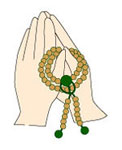
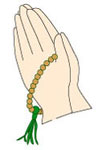
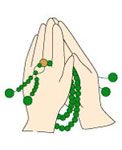
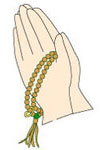

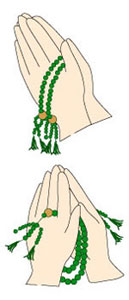
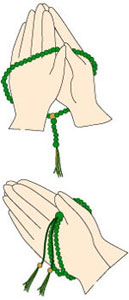
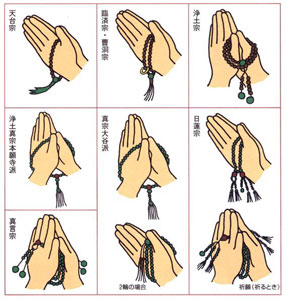
Juzu 数珠
Rosaries come in three forms: 108 beads, 54 beads, and 27 beads. All have at their base either a manji (swastika), representing the primal movement of the spirit within the heart; or a pagoda, representing the storehouse of the scriptures, which the turning of the rosary causes to be revolved; or a fish biting an iron ball which it can neither swallow nor spit out; or a tassel or pair of tassels, representing the roots of the Lotus, the symbol of enlightenment, with its roots in the mud of human suffering. No matter what may be at the base of the rosary, it is always a symbol of activity and movement, whether the movement of the heart, i.e. the manji; the turning of the scriptures, i.e. the pagoda; the struggle of the kōan, i.e. the fish with the iron ball; or the nourishment of enlightenment from suffering, i.e. the tassel. Immediately above this symbol are three beads representing the Three Refuges: Homage to the Buddha, Homage to the Dharma, Homage to the Sangha. A 108 bead rosary is divided into 6 groups of 18 with a divider between each. A 54 bead one has 6 groups of 9 with a divider between each, and a 27 bead one, 2 groups of 6 and 1 of 15 divided by 2 dividers. All divider beads in a rosary represent points of pause for silent meditation, the putting of the hands in gassho while holding the rosary, or the putting of the brain, as it were, into gasshō.
Uses of the Buddhist Rosary
Rosaries may be used in the following ways: a) for beginning Buddhists, to quiet the mind by counting the breaths, one bead for an in-breath, one bead for an out-breath, and a gassho at the spacer. b) They may be used for the transfer of merit for sick or dying persons or any other cause whatsoever by thinking of the purpose for which the recitation is to take place when holding the symbol, reciting the Three Refuges, pausing on the center spacer for a moment of silent meditation, reciting the name of a Bodhisattva on each bead, with pauses for silent meditation at each spacer, a return to the recitation of the Three Homages at the end of one full circuit and again the thought of the purpose of the recitation on the symbol. Example: The person who wishes to transfer the merit to a dying relative would first hold the manji while thinking of turning the merit of the wheel by the love in his heart towards that person. He would then take the Three Refuges for that person and for himself, reflecting silently on the center spacer and, if his rosary were a 27 bead one, recite "Hail to Avalokitesvara Bodhisattva" on each of the first beads, meditate silently for a moment on the spacer, recite "Hail to Avalokitesvara Bodhisattva" on the next l5 beads, reflect silently on the spacer, and then recite "Hail to Avalokitesvara" on the last 6, pause silently on the center spacer for thoughtful meditation, again take the Three Refuges and pause on the symbol to think on the way in which he can best transfer the merit by the movement of his heart, if the symbol be a manji, or the turning of the scriptures, if it be a pagoda. This procedure is followed for all size rosaries; obviously there are other purposes for which you would wish to transfer merit. Perhaps you would wish merit for yourself, for which it is equally permitted to recite a rosary, or to calm your own mind or to keep it from wandering while on a bus or other public transportation. The uses of the rosary are too innumerable to give all of them here. The sincere Buddhist will discover many for himself. One more example can be given: a person who wishes to transfer the merit of wisdom on a 27 bead rosary could recite "Hail to Avalokitesvara Bodhisattva" on the first 6 beads (transferring compassion), "Hail to Samantabhadra Bodhisattva" on the next 15 (transferring love) and "Hail to Manjusri Bodhisattva" on the last 6 (thus transferring wisdom which is the child of Avalokitesvara and Samantabhadra).akushaju 悪叉聚 Sk. aksa, rudraksa; the name of a plant which bears a cluster of fruit; Eleocarpus Genitrus; the core of its fruit is used for rosaries.
bodaishi 菩提子 The name of a fruit produced in the Himalayas and called 'bo-di-ci' (or bo-dhi-rtsi ) in Tibetan, which is used for making rosaries. The term is often incorrectly taken to mean the fruit of a bodaiju (Bodhi-tree).
*
The Buddhist rosary is known in Japan as a 念珠 nenju or alternatively, a 数珠 juzu. Nenju refers to 'beads used for mindful practice', and juzu translates as 'counting beads'.
The nenju has a number of uses in Japanese Buddhism. To count the number of prayers, mantras, dharani, etc., it may be held in the palms and the beads rubbed together as you pray. it may simply be rotated in the hands. it may be placed over either the left hand alone, or over both hands held together in gassho. it is also considered to be a protective charm against evil spirits - imbued as it is with the spiritual 'fallout' of all the devotions & meditations in which it has been used.
Nenju are frequently given as gifts - for example - to celebrate a birth, marriage, a coming-of-age, etc. They are also given as keepsakes and a source of protection to loved ones.Nenju are objects to be treated with respect and taken care of. They should not be left lying around carelessly, and should be cleaned and kept in good repair. Nenju that are beyond repair should be disposed of properly - normally they would be taken to a Shinto Shrine, where, along with old good-luck charms, they will be respectfully ritualistically disposed of by the priests.